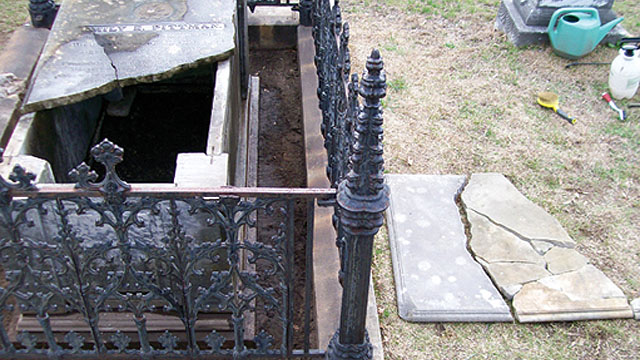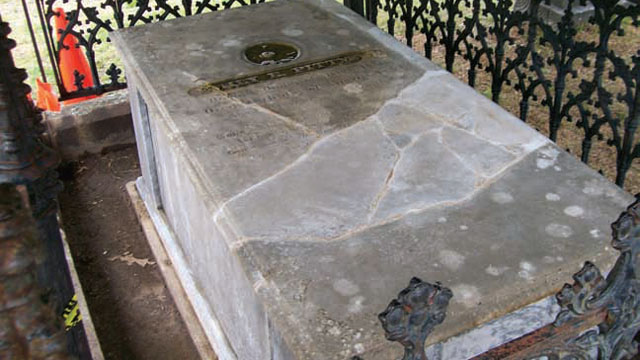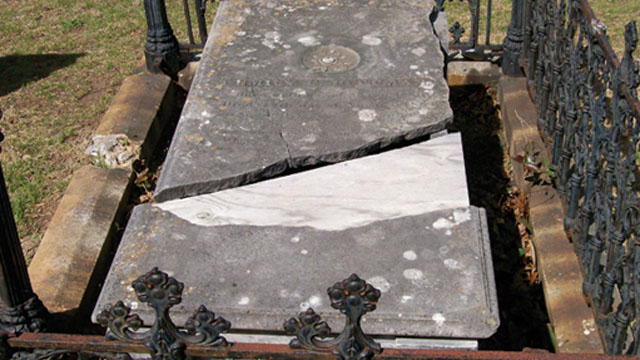June 24, 2011 7:00 AM CDT
According to the cemetery superintendent, the tomb’s lid, measuring about three feet wide, six feet long and two inches thick, had been disturbed by vandals who shifted and dislodged it in an effort to reach any existing contents. The cemetery staff had realigned and straightened the shifted top repeatedly, but eventually found it shattered into more than 14 pieces on the ground.
In spring 2009, I was contracted to repair and preserve the heavily damaged historic monument through collaboration between the Decatur Preservation Alliance and the City of Decatur. The largest portion of the fractured top already had been lifted back into place, at the head of the tomb, by cemetery staff. The second-largest of the broken pieces was positioned at the foot of the tomb, above a piece of plywood, also covering the gaping hole that the shattered section had once spanned.
Inside the box were dirt, debris and 10 small pieces of marble, also referred to as “fragments,” which had been placed inside the box prior to the plywood top.

A quality stone epoxy was selected to join the broken pieces together, Akemi, Akepox 2030. Epoxies are, by far, the strongest adhesive used for joining stone. Historically, mortars often were employed for this purpose, but in order for a mortar to have high strength, it needs to be about one-quarter-inch thick, which would push the fragments apart, resulting in unsightly joints.
Drilling holes and installing blind pinning, often composed of some kind of metal, is a common method used to invisibly reinforce a broken stone. Although the concept is to add support with an internal frame, it also can have the effect of weakening the stone along a fault line. Once a hole is drilled into an object, it is forever diminished, and the alteration is non-reversible. If the repair fails at some future date, the stone often will splinter out into small chips projecting from the pin holes, complicating future repair treatments.
The decision was made to construct an internal masonry structure to help support the marble top in order to allow some internal movement from changes in humidity and temperature. Dry-fit cement blocks, natural stone blocking and shims were fit to match the exact height of the sidewalls. Thin lead shims also were fitted to fine-tune the internal support structure to match the sidewall height.
All of the fragments were cleaned prior to being joined together. Marble is highly prone to erosion from any form of acid. A product called “D2 Biological Cleaning Solution,” which is non-acidic and safe for all masonry, was applied to clean the fragments, lightly brushed and rinsed. A small plywood platform was constructed beside the tomb. All of the small fragments were carefully joined together with the stone epoxy.
After the epoxy cured, the repaired section was lifted onto the top and dry fitted with the other 2 large pieces of stone. Some warping and hairline cracks also had occurred, so lead shims and padded bar clamps helped align the top after the epoxy had been applied to one side of each mating surface along each fracture.
Once joined together, little chips and missing stone became visible along the joint lines. A composite stone repair patching material was used to in fill the voids. Jahn’s Restoration Mortars are cementitious, mineral-based mortars formulated to match the porosity, texture and color of the substrate being repaired. Jahn’s M120 Marble Repair Mortar was applied to the dampened surface, left higher than the stone surface and, after beginning to dry, cut down flush to match the stone. It then needed to be kept moist with light repeated misting, for at least a few days, in order to cure properly.
Although all the individual fragments had already been cleaned, many were still soiled. D2 was liberally applied to the entire tomb, late in the day, and then left well covered overnight. The following day, the entire top had turned orange. When working with D2, a change on color is a good thing, it means the biological growth is being killed off, and the smell it produces also is memorable. After lightly hand brushing and rinsing well, the marble top began looking white again, although another interesting attribute of D2 is the continued cleaning action to the masonry for a month or longer.
The final treatment performed was the application of a product that consolidates, strengthens and provides protection from weathering and acid resistance. Conservare HCT was applied with a hand pump sprayer to the entire tomb, in multiple applications until rejection, followed by HCT Finishing Rinse.

Saving Miss Emily
Rehab/Restoration case studies

Before
“Miss Emily,” a 19th century marble box crypt tomb and memorial in Decatur (Ga.) Cemetery, marks the grave of an unknown child. The above-ground monument is styled to look like a tomb but is, however, an empty as the remains of the departed are buried underground, beneath the lower slab of the box.According to the cemetery superintendent, the tomb’s lid, measuring about three feet wide, six feet long and two inches thick, had been disturbed by vandals who shifted and dislodged it in an effort to reach any existing contents. The cemetery staff had realigned and straightened the shifted top repeatedly, but eventually found it shattered into more than 14 pieces on the ground.
In spring 2009, I was contracted to repair and preserve the heavily damaged historic monument through collaboration between the Decatur Preservation Alliance and the City of Decatur. The largest portion of the fractured top already had been lifted back into place, at the head of the tomb, by cemetery staff. The second-largest of the broken pieces was positioned at the foot of the tomb, above a piece of plywood, also covering the gaping hole that the shattered section had once spanned.
Inside the box were dirt, debris and 10 small pieces of marble, also referred to as “fragments,” which had been placed inside the box prior to the plywood top.

Looking for a solution
A Solution
The project’s primary focus entailed joining the 14 fragments back into one piece, then lifting it into place, adhered and centered on the lower base section. The repairs needed to be performed in a way that would last, which also would greatly minimize the chance of future vandalism. An innovative plan was needed.A quality stone epoxy was selected to join the broken pieces together, Akemi, Akepox 2030. Epoxies are, by far, the strongest adhesive used for joining stone. Historically, mortars often were employed for this purpose, but in order for a mortar to have high strength, it needs to be about one-quarter-inch thick, which would push the fragments apart, resulting in unsightly joints.
Drilling holes and installing blind pinning, often composed of some kind of metal, is a common method used to invisibly reinforce a broken stone. Although the concept is to add support with an internal frame, it also can have the effect of weakening the stone along a fault line. Once a hole is drilled into an object, it is forever diminished, and the alteration is non-reversible. If the repair fails at some future date, the stone often will splinter out into small chips projecting from the pin holes, complicating future repair treatments.
The decision was made to construct an internal masonry structure to help support the marble top in order to allow some internal movement from changes in humidity and temperature. Dry-fit cement blocks, natural stone blocking and shims were fit to match the exact height of the sidewalls. Thin lead shims also were fitted to fine-tune the internal support structure to match the sidewall height.
All of the fragments were cleaned prior to being joined together. Marble is highly prone to erosion from any form of acid. A product called “D2 Biological Cleaning Solution,” which is non-acidic and safe for all masonry, was applied to clean the fragments, lightly brushed and rinsed. A small plywood platform was constructed beside the tomb. All of the small fragments were carefully joined together with the stone epoxy.
After the epoxy cured, the repaired section was lifted onto the top and dry fitted with the other 2 large pieces of stone. Some warping and hairline cracks also had occurred, so lead shims and padded bar clamps helped align the top after the epoxy had been applied to one side of each mating surface along each fracture.
Once joined together, little chips and missing stone became visible along the joint lines. A composite stone repair patching material was used to in fill the voids. Jahn’s Restoration Mortars are cementitious, mineral-based mortars formulated to match the porosity, texture and color of the substrate being repaired. Jahn’s M120 Marble Repair Mortar was applied to the dampened surface, left higher than the stone surface and, after beginning to dry, cut down flush to match the stone. It then needed to be kept moist with light repeated misting, for at least a few days, in order to cure properly.
Although all the individual fragments had already been cleaned, many were still soiled. D2 was liberally applied to the entire tomb, late in the day, and then left well covered overnight. The following day, the entire top had turned orange. When working with D2, a change on color is a good thing, it means the biological growth is being killed off, and the smell it produces also is memorable. After lightly hand brushing and rinsing well, the marble top began looking white again, although another interesting attribute of D2 is the continued cleaning action to the masonry for a month or longer.
The final treatment performed was the application of a product that consolidates, strengthens and provides protection from weathering and acid resistance. Conservare HCT was applied with a hand pump sprayer to the entire tomb, in multiple applications until rejection, followed by HCT Finishing Rinse.

After
The Result
I returned to Decatur, Ga., recently to perform another project, and I looked in on Miss Emily. Two years have passed, and the tomb is still undisturbed and clean.About the Author
Jonathan Appell is a gravestone conservator and preservation mason who delivers gravestone conservation training workshops and stone preservation projects throughout the United States. Contact him at 860-558-2785 or historicstone@msn.com, or visit www.gravestoneconservation.com.


















